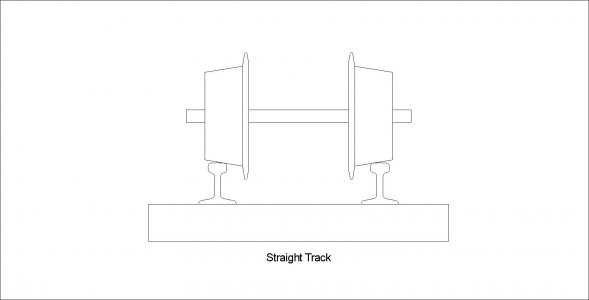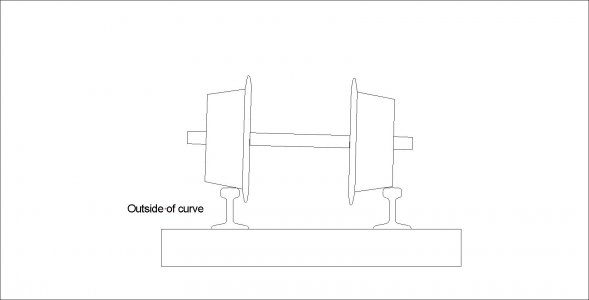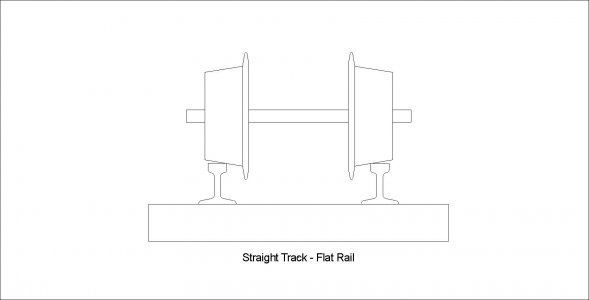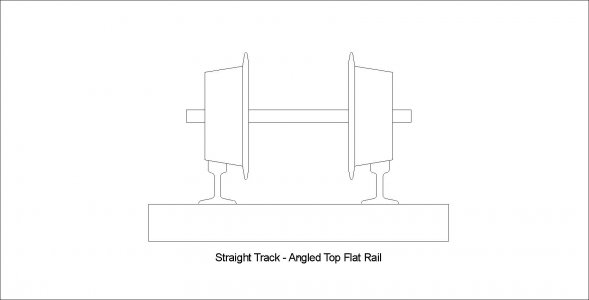RAILS AND WHEELS - PART II
Okay, first we'll talk about the wheels, as they have the greatest effect on what happens with the behavior of a rail axle, truck, and car. As mentioned earlier, the wheel tread is angled nearly 3°, (a maximum of 2° 50') for IBLS standards, but the standards for G gauge call for a straight 3°. I have included a drawing here with the tread angles slightly exaggerated so that the physics are more apparent. This drawing is of a set of wheels on straight track. Click on the thumbnail to see the full sized image.

When the truck is traveling down straight track, it is easy to see that gravity will tend to center the axle on the rails, and the flanges are totally unnecessary to stay on the track. In reality, if the car were loaded heavy on one side, the wheels would tend to move over a little bit to self center the load, correct? NOPE. Here is why: We all know how cars and trucks have differential gears on the drive axle so that turns or curves can be negotiated while allowing the two drive wheels to turn at different speeds yet allow for the longer distance that the outside wheel has to travel. Right? Okay, so what happens with a rail car axle? It is solid, no differential gears, both wheels are solidly affixed to the axle, requiring that they both turn at the same speed as they negotiate a curve. This creates a bit of a quandary, doesn't it? It maybe even goes against everything that we've learned before. Well, the axle will center itself between the rails (regardless of uneven loading) until both wheels have the same diameter in contact with the rails, allowing them to travel at the same speed as they head down the track. In a perfect world we wouldn't even need the flanges at all. Have you ever been watching a train as it goes around a curve or through a switch and you hear loud screeching from time to time? That noise is what is known as 'flange squeal' and it is caused by the flange coming in contact with the side of the rail. As the flange rubs the rail, it does so with a wiping action, causing the squeal. That wiping action is also what can cause a wheel to climb a rail and cause a derailment if the wiping action is strong enough. It seldom happens on straight track, but becomes more prevalent on curves or when going through switches when the flanges are said to 'pick' at the rails.
So we are headed down straight track, the cars are running centered on the rails, and there is little if any flange squeal. Perfect! There is also very little rolling resistance due to the very narrow contact area between the wheel and the rail, but the rolling resistance increases significantly when a flange starts rubbing on a rail, such as on a sharp curve. Full sized railroads actually install 'flange oilers' just prior to track with severe curvature. The oil on the flange reduces the friction between the flange and the rail, reducing the power required to get the train around that curve but even more important, it helps reduce the wiping action that could potentially cause a wheel to climb the rail and derail.
Since we are talking about curves, how do the axles on rail cars deal with the longer rail on the outside of a curve? There is no differential, so just how does this work? Quite simple! Refer to the drawing below.

We already know that the wheels will find their own happy medium on straight track, and for the most part they do the same thing on curved track as shown in the drawing. Both wheels are turning at the same speed, but the axle will shift toward the outside rail so that the effective larger diameter of the outside wheel will turn at the same speed as the effectively smaller wheel on the inside rail. This also gives the added advantage of slightly elevating the side of the car that is nearer to the outside of the curve, helping to move the center of gravity toward the inside of the curve, which in turn helps to counteract the centrifugal force created by traveling around the curve. WOW! It's like magic! Well, not really, but I will bet that most folks never realize just how much science is taking place on a simple railroad track.
So okay, now we know why the wheels have an angled tread, so let's have a look at the rail. Granted this is not too important in the small gauges, but it is good to be aware of just the same. First we will look at flat topped rail as shown in the image below.

As we can see, the contact point between the wheel and the rail is very, very small. The problem with this is that the load placed on that point of the rail will tend to cause the corner of the rail to fracture and crack. We all know what happens with cracks: once they start, they keep on going, right on through the entire rail. Using rail that has a slight radius on the top allows for a small contact point for reduced rolling resistance, but the wheel contacts the rail on a surface that is well supported and less prone to load fracture. Okay, so that was easy, why not taper the top of the rail to match the wheel tread?

Very simple, and it should be obvious based on the drawing above. Here we effectively have an unlimited number of diameters contacting the rail, all turning at the same speed. Only one diameter can run true on the rail, which one will it be?? Don't know, most likely the largest diameter I suspect as it would have greater leverage over the smaller diameters. But, the rest of the wheel tread would be scrubbing on the rail the entire time. The rolling resistance would be PHENOMONAL! Not a good thing.
So how does all of this affect our model trains? As we can see the tapered wheel treads will still be a necessity, as well as the angles on the flanges and the radius on the very outside of the flange diameter. The angles and radii on the flanges help to reduce rail picking and flange scrub, reducing it to one small point rather than occurring across the entire flange. This all reduces rolling resistance, allowing a smaller locomotive to pull a much longer and heavier train, while greatly reducing the chance of a derailment. As for the rail material and shape, the wheel loading is not nearly so high with our models as with full sized railroads, thus flat topped rail will work without causing rail failure. Remember that in theory the contact point is infinitely small, regardless of the size of the wheel, yet the loading is far greater on prototype equipment. This is why full size tracks are made of high grade steel while many live steam railroads use aluminum rail and it works just fine because the load at the wheel/rail contact point is just a tiny fraction of a full sized wheel. As the models get smaller, this loading is reduced even further, yet the actual contact point remains the same size for all practical purposes.
So, in my estimation, there comes a point where wood rails should be feasible, and G gauge might just be the size to try it on. A flat topped rail should work, as the corner of the rail would simply compress slightly over time and might even give a slightly curved surface over time. Personally I suspect that you will see little change in the wood over time. I would not be to concerned about it being too slippery when wet as I suspect wood will have a better overall coefficient of friction compared to steel or aluminum, wet or dry.
James, the only thing that I would consider differently for your project would be the material for the wheels on the cars. These cars are very light and are lightly loaded, thus there is no real need for metallic wheels. I would try black Delrin first, and if it did not meet my expectations, then I would try aluminum. Delrin machines very easily, and it is already the right color for wheels. You could rough machine your wheel profiles then use a couple of form tools to get the final wheel profile that you are after. They would also press onto the axles very nicely and you would not have to worry about corrosion between dissimilar metals that would occur between stainless steel and aluminum. Delrin is also self lubricating for the most part, you could make your axle journals out of Delrin also.
One other thing, James. You don't need to measure the Bachman wheels. Click here for
G Gauge Wheel Standards
So there you have it gentlemen, a quick explanation of why rails and wheels are shaped as they are. There are other details that I did not go into, but they are small things that do not really cause any issues in model gauges.







